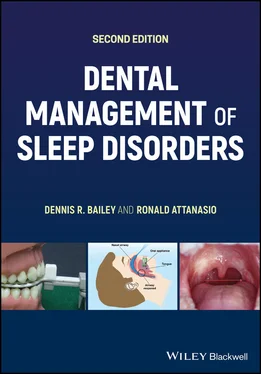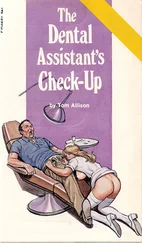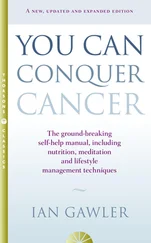Ronald Attanasio - Dental Management of Sleep Disorders
Здесь есть возможность читать онлайн «Ronald Attanasio - Dental Management of Sleep Disorders» — ознакомительный отрывок электронной книги совершенно бесплатно, а после прочтения отрывка купить полную версию. В некоторых случаях можно слушать аудио, скачать через торрент в формате fb2 и присутствует краткое содержание. Жанр: unrecognised, на английском языке. Описание произведения, (предисловие) а так же отзывы посетителей доступны на портале библиотеки ЛибКат.
- Название:Dental Management of Sleep Disorders
- Автор:
- Жанр:
- Год:неизвестен
- ISBN:нет данных
- Рейтинг книги:3 / 5. Голосов: 1
-
Избранное:Добавить в избранное
- Отзывы:
-
Ваша оценка:
- 60
- 1
- 2
- 3
- 4
- 5
Dental Management of Sleep Disorders: краткое содержание, описание и аннотация
Предлагаем к чтению аннотацию, описание, краткое содержание или предисловие (зависит от того, что написал сам автор книги «Dental Management of Sleep Disorders»). Если вы не нашли необходимую информацию о книге — напишите в комментариях, мы постараемся отыскать её.
Dental Management of Sleep Disorders
Dental Management of Sleep Disorders, Second Edition
Dental Management of Sleep Disorders — читать онлайн ознакомительный отрывок
Ниже представлен текст книги, разбитый по страницам. Система сохранения места последней прочитанной страницы, позволяет с удобством читать онлайн бесплатно книгу «Dental Management of Sleep Disorders», без необходимости каждый раз заново искать на чём Вы остановились. Поставьте закладку, и сможете в любой момент перейти на страницу, на которой закончили чтение.
Интервал:
Закладка:
1 Occurrence
2 Geographic distribution
3 Population patterns of disease
4 Search for determinants of the observed patterns
Specifically, clinical epidemiology applies to how the occurrence of a particular condition, in this case a sleep disorder, is related to the occurrence as well as the distribution of a disease and how this impacts other risk factors. The ultimate goal is the improvement in people's health. Currently, the most common sleep disorders based on epidemiologic studies are [7]:
Insomnia
Sleep apnea
Restless leg syndrome (RLS)
The ultimate outcome of these early epidemiologic studies of sleep resulted in the first published classification of sleep disorders that over time has been modified and revised. At the current time, the International Classification of Sleep Disorders, third edition, (ICSD‐3) is the evidence‐based standard for the diagnosis of sleep disorders [8].
The general onset of sleep disorders as well as their progression is to some degree dependent on age, the presentation of being at risk for health‐related consequences, and even trauma. In many instances, these disorders may appear as a health issue as well as some type of emotional or psychological condition. In many instances, it is the presentation of the health problem that is first recognized or diagnosed that may have its origin as a sleep disorder. As an example sleep apnea patients may seek treatment and use more healthcare resources for the diagnosis of the cardiovascular disease (CVD) and more specifically hypertension prior to the diagnosis of the underlying cause, that being the sleep apnea [9].
The prevalence of sleep disorders based on epidemiologic studies is most often cited as occurring in each of the specific one’s as opposed to a general statistic overall. Hence, the actual distribution of a specific sleep disorder is variable dependent on the study that is presented. As an example, it is best to consider the three most common sleep disorders as previously cited.
Prevalence of Sleep Apnea
An example of the most often cited study on the prevalence of sleep apnea is from a 1993 study that was published in the New England Journal of Medicine [10]. In this study of 602 people, it was determined that 24% of men and 9% of women are at risk for sleep‐related breathing disorders (SRBDs). When this same group also had daytime hypersomnolence, the prevalence of sleep apnea was determined to be 4% of men and 2% of women. A more current study in 2013 found that there was an increase in prevalence of SRDB that ranged from 14 to 55% based on age, sex, and severity of the apnea hypopnea index (AHI) [11]. This study looked at age groups by their sex and found that in men the prevalence was 10% (age 30–49) and was 17% (age 40–70). In women, the prevalence was 3 and 9%, respectively for the same age groups. The prevalence in this case was based on an AHI of 15 or greater. When an AHI of 5 or more was considered, in ages 30–70, along with daytime sleepiness, the prevalence was determined to be 14% in men and 5% in women.
Since 2013, there have been other studies that have determined the prevalence of SRDB. The facts from two other studies that are significant merit consideration.
1 A study commissioned by the American Academy of Sleep Medicine (AASM) determined that approximately 80% or 23.5 million people who are at risk for sleep apnea in the United States are undiagnosed [12]. Estimation of the prevalence of obstructive sleep apnea (OSA) is at 12% or 29.4 million adults in the United States. Based on this, it was determined that this is having a major impact on the healthcare system. The estimated annual cost per individual in 2015 who is undiagnosed is $6366 as compared to the healthcare costs for someone who is diagnosed and being treated was $2105.
2 It has been determined that worldwide the prevalence of sleep apnea now approaches nearly one billion (936 million) people [13], based on a review of the data available from 16 countries and considering people age 30–69. When considering those who have more moderate to severe sleep apnea the prevalence is 425 million. The impact was most significant in China and then the United States followed by Brazil and India.
Prevalence of Insomnia
For insomnia the prevalence may vary based on the study but in general it appears to be around 33% of the population [2]. The majority of the insomnia complaints focuses on the inability to maintain sleep. Percentages will vary based on the defined criteria that may exist as a result of the specific study parameters. There are two frequently cited studies regarding the prevalence of insomnia. The first indicates that 29.9% of people report insomnia symptoms and 9.5% satisfy the criteria for a diagnosis [14]. Second, it was found that 34.5% of the population had at least one of three symptoms that were present three nights per week and 9.8% were found to have symptoms along with daytime complaints [15]. It is important to understand that insomnia is the most frequent complaint in a primary care practice.
Prevalence of Restless Leg Syndrome (RLS)
The prevalence of RLS, or Willis–Ekbom disease as it is currently termed, is estimated to be between 2.5 and 10% of the general population [16]. Many of the studies have limitations due to misdiagnosis and because patients may not seek medical care. With improved criteria for making a diagnosis the recognition of RLS may actually result in an increased prevalence. A study in 2012 reviewed a variety of previously published studies [17]. In general, the outcome is that the prevalence is between 3.9 and 15% but may vary depending on the structure of the study. Other reported findings are that RLS appears to be more prevalent in females, less common in Asia, and can be worse with age and some health issues.
Increasing Awareness of Narcolepsy
Narcolepsy is another sleep disorder that has been studied epidemiologically. At the present time, its prevalence is between 25 and 50 people per 100 000 [18]. Currently, it is stated that narcolepsy has a similar prevalence to multiple sclerosis. A more current publication indicates that the prevalence is 1 for every 2000 people and it is estimated that about 50% may be undiagnosed [19]. Over the upcoming years more research will be done, and as more data is gathered the actual prevalence of Narcolepsy will be better defined and hence the recognition as well as management strategies should improve.
Risk Factors
There are a multitude of risk factors that may impact the onset as well as the progression of a specific sleep disorder. The risk factors may be different for each specific sleep disorder and overlapping risk factors may be present that apply to a number of different sleep disorders and are becoming increasingly common. In general, the demands of modern‐day life have impacted the quality of one’s sleep as well as the required amounts that are deemed appropriate. In addition, the disruption of an individual's sleep can impact other family members, roommates, or one's bed partner. As an example, a study published in the Mayo Clinic Proceedings as it relates to sleep related breathing disorders (SRBD) clearly demonstrated that the snoring of one person significantly impacted the sleep of the bed partner to the point that the effected person had symptoms that were worse than those of the snorer [20].
The more common risk factors associated with the three most common sleep disorders as previously discussed are discussed elaborately in other chapters ( Table 1.1).
The prevalence of sleep problems related to comorbid illness is well recognized. The more health‐related problems that exist the greater the chances that a sleep disorder as well as sleep complaints may be related. This is especially true when one considers people who are older; however, the comorbidities were found to be more significant than age [21]. The number of morbidities reported in another study, referred to as multi‐morbidities, correlated mostly to reports of sleep duration, short as well as long sleep, and to sleep quality [22]. Alteration in sleep duration as well as sleep quality may be associated with a number of chronic health issues as well. This study demonstrates that the presence of multi‐morbidities in conjunction with sleep quality and duration poses concern from a public health point of view ( Table 1.2).
Читать дальшеИнтервал:
Закладка:
Похожие книги на «Dental Management of Sleep Disorders»
Представляем Вашему вниманию похожие книги на «Dental Management of Sleep Disorders» списком для выбора. Мы отобрали схожую по названию и смыслу литературу в надежде предоставить читателям больше вариантов отыскать новые, интересные, ещё непрочитанные произведения.
Обсуждение, отзывы о книге «Dental Management of Sleep Disorders» и просто собственные мнения читателей. Оставьте ваши комментарии, напишите, что Вы думаете о произведении, его смысле или главных героях. Укажите что конкретно понравилось, а что нет, и почему Вы так считаете.











